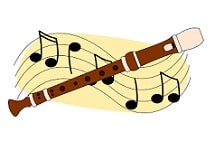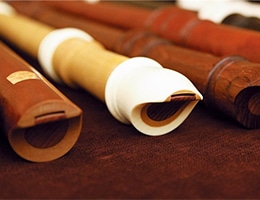 Originating in the Occitan language, flute is a term that refers to a wind instrument that has a tubular shape. Flutes have holes that the musician must cover or not, either with his fingers or with a key , depending on the note he intends to play.
Originating in the Occitan language, flute is a term that refers to a wind instrument that has a tubular shape. Flutes have holes that the musician must cover or not, either with his fingers or with a key , depending on the note he intends to play.
Generally, this type of musical instrument is made of wood, although metal, resin, bone or plastic, among other materials, can also be used. To produce the sound , the person must place their mouth on the mouthpiece of the flute and blow into the bevel . Depending on the type of flute, the air may pass through the tube directly or enter a channel.
Most flutes are played facing the front: this way, the instrument is in front of the face . This is the case of the recorder , one of the most popular, whose mouthpiece is at the upper end. On the other hand, the transverse flute , also known as the transverse flute or transverse flute , is played sideways, since the upper end is closed and the embouchure is located on one side.
The recorder is made of various materials, with plastic and wood being the two most common options. The former are cheaper, and that is why they are ideal for students who do not have enough money to access a higher quality one or the experience to take full advantage of it. The popularity of this instrument is not recent, but dates back to the 14th century.
The sound of the recorder is very soft, although in the hands of a beginner it can also be squeaky. Because it is considerably easier to play than most instruments, it is usually the first one that music teachers teach children to play in school. One of the reasons why it does not present major challenges is the impossibility of making chords: we can only play one note at a time, unlike a guitar or piano.
 Learning to play the recorder during the first years of education is very useful for developing hearing and improving motor skills. In addition, it gives children a tool to imitate and analyze the dozens of melodies they hear in their daily lives, whether on the radio, on television or even while walking down the street: translating all this into sequences of notes is the first step towards solfeggio , that is, the basis of academic music.
Learning to play the recorder during the first years of education is very useful for developing hearing and improving motor skills. In addition, it gives children a tool to imitate and analyze the dozens of melodies they hear in their daily lives, whether on the radio, on television or even while walking down the street: translating all this into sequences of notes is the first step towards solfeggio , that is, the basis of academic music.
The plastic recorder is not only cheaper than the wooden one, but it is also easier to maintain. It is important that adults teach children to clean it and protect it from knocks. Basic models are sold in one piece , while more expensive ones usually come in three parts: the mouthpiece, the segment with the holes to produce the notes, and the bell-shaped tip. Before using one of the latter, it is necessary to assemble it, joining its three pieces.
In some Latin American countries, on the other hand, a long bread that is characterized by having a spongy crumb covered by a harder crust is called flauta. Flautas are often used to prepare sandwiches. Also, in Mexico , a cue that is longer than usual is called a flute .
In certain regions, finally, the interjection "Ah, the flute!" It is used to express astonishment or admiration : «Is it true that you scored six goals in the game this morning? Ah, the flute! , «Ah, the flute! "I didn't know the portions were so generous in this restaurant."
